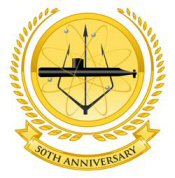
Ship's Commissioning
01 Oct 1958

|
USS SARGO (SSN 583)
Ship's Commissioning |

Click on the pictures to enlarge!

|
At the moment the commissioning pennant is broken, a ship becomes the
responsibility of the Commanding Officer, who, together with the ship’s officers
and men, has the duty of making her ready for any service required by our
nation, whether at peace or at war.
The commissioning pennant has for centuries been the symbol of a man-o-war. It is believed to date from the 17th century, when the Dutch were at war with the English. Dutch Admiral Maarten Harpertzoon Tromp hoisted a broom at the masthead to symbolize his intention to sweep the English from the sea. This gesture was answered by British Admiral William Blake, who hoisted a horsewhip indicating his intention to chastise the Dutch. The victorious Brittish thus set the precedent for a long, narrow commissioning pennant to symbolize the original horsewhip as the distinctive symbol of a ship of war. The modern U.S. Navy commissioning pennant is blue at the hoist with a union of seven white stars and a horizontal red and white stripe at the fly. The original design had 13 rather than 7 stars, but the number was reduced as the length of the pennant was shortened over the years. The ceremonies for commissioning and decommissioning a U. S. Navy warship call for the hoisting of the ensign, jack, and commission pennant as the first act after the new captain has read the commissioning order, and as the final act before the last captain declares the ship decommissioned. The commissioning of the USS SARGO took place at Mare Island Naval Shipyard, Vallejo, California on 01 Oct 1958. Reading from the ship’s Commissioning Program (provided courtesy Frank Munroe) the ceremony and the ship were described as follows: |
|
“The U. S. S. SARGO (SS(N) 583) is being commissioned today as the newest in
the Navy’s growing fleet of nuclear powered submarines. SARGO is the first
nuclear powered submarine to be built on the West Coast. Her keel was laid on
21 February 1956 and she was launched on 10 October 1957. She is 267 feet long,
displaces 2350 tons and can steam around the world without refueling. She
carries a crew of more than 80 officers and men. SARGO is an attack type
submarine and is equipped with the newest torpedoes and the most advanced
electronic and fire control equipment.
“The United States and the free world today face a formidable threat from a large number of Soviet submarines, many of which are capable of launching missiles with nuclear warheads. Defense against this threat in great part will be dependent upon an adequate number of United States nuclear-powered attack submarines, coupled with the deterrent effect of adequate numbers missile carrying nuclear submarines." |
| One of the photos released to the press is shown below: |
| The Vallejo Times-Herald newspaper story which accompanied the photo above: |
|
The Pacific Coast’s first nuclear-powered submarine – USS Sargo – formally
joined the fleet yesterday afternoon at Mare Island Naval Shipyard amid
sun-drenched ceremonies attended by about 700, largest gathering at a Mare
Island commissioning since World War II days. The ship was turned over to
Comdr. Daniel P. Brooks, USN, named more than a year ago as her prospective
commander.
Commissioning of the Sargo yesterday culminated four years of preparation,
planning, research, design and the actual building of the nuclear under-sea
craft. The ceremonies, in a sense, marked Mare Island’s graduation into the
ranks of the nuclear-ship building yards.
HER COST, $48 million makes the Sargo the most expensive of the nearly 500
ships delivered to the fleet by Mare Island in the shipyard’s 104-year history,
but her commissioning speaker, Vice Adm. Maurice E. Curts, USN, commander of
the Western Sea Frontier and Pacific Reserve Fleet, declared: "She will show a
fine net return, whether we are at war or at peace."
Admiral Curts added, however, as he addressed the audience from the crowded
deck of the Sargo: "To achieve the maximum return will demand imagination and
judgment," and directing his remarks to the officers and crew: "You and your
men are the pioneers of America’s new Navy, and I know that you are inspired
by Commander William K. Anderson and the Nautilus, and Commander Calvert,
skipper of the Skate, sister ship of the Sargo."
The speaker also paid tribute to Mare Island workmen, noting that "today is
truly an historic occasion, because, up to now at least, it could happen only
once in a lifetime. It happened when you built sailing ships. It happened again
when you built the first coal-burning ship, and again when you built the first
oil-burning ship.
"AND NOW," he said, "you have built a nuclear-powered submarine. It would be
difficult to imagine what the next power transition will be, but when it comes,
I am confident your descendents in Mare Island Shipyard will be building that,
too."
Admiral Curts went on to praise the other principal contributors to the
building of the Sargo - the Bureau of Ships, headed by Rear Adm. Albert G.
Mumms, USN, a former Mare Island Naval Shipyard commander, which was
responsible for design; the Bureau of Ordinance for the weapons system, and to
the Reactor Division of the Atomic Energy Commission, headed by Rear Adm. Hyman
G. Rickover, USN.
The Sargo is probably the most nearly completed ship Mare Island has ever
commissioned, already having logged more than 1,500 miles in sea trials. These
recent and outstandingly successful trials were noted by Admiral Curts as he
"borrowed a page" from the report on them from the absent shipyard commander
Rear Adm. Martin J. Lawrence, USN.
"ADMIRAL, Lawrence said on her first trip to sea, 'we were able to run
up to full power and keep her there for several hours. We were able to bank her,
turn her, back her down full, and practically stand her on her head, and she
performed like a thoroughbred'," the speaker quoted from the report.
Then he said, " I don't know why it should be necessary to stand a submarine on
her head, but the Sargo apparently is capable of it."
To Commander Brooks and the officers and crew of the Sargo, Admiral Curts said
as he concluded his address: "I congratulate you. I wish you well. I wish you
smooth sailing. And I wish you peaceful sailing!"
Since the Sargo already has been to sea, she was flying the American flag at
her commissioning yesterday and only the commissioning pennant was raised.
THE SUBMARINE'S imminent availability as a member of the Pacific
Submarine Force was noted with relish by the force commander, Rear Adm. Elton
W. (Joe) Grenfell, USN.
"The Pacific Submarine Force and the whole Pacific Fleet feel this is a most
magnificent day for them, for we are anxiously awaiting the Sargo," Admiral
Grenfell said.
"We have been waiting to try out new tactics using the Sargo's high speed and
endurance. We want to use her with conventional submarines to see if or how well,
the complement each other. We want to use her as a target in anti-submarine
warfare; in fact, much of Sargo's time will be devoted to that important task,"
he added.
THE FORCE commander promised the sub's crew a busy time in the months
ahead, forecasting tours of duty with the Seventh Fleet in the far East and visits
to the SEATO nations.
Terming the ship a "magnificent masterpiece" of Mare Island's, Admiral Grenfell
declared himself as certain the Sargo crew would make her "the outstanding sub
in the Force."
He then read a message of congratulations for Adm. Herbert G. Hopwood, USN,
commander-in-chief of the Pacific Fleet.
Admiral Grenfell, who was introduced by Capt. Lowell T. Stone, USN, commander of
Mare Island Submarine Administration, then introduced Rear Adm. Elmer E. Yeomans,
USN, now superintendent of the Naval Post-Graduate School in Monterey, but who was
the first skipper of the original Sargo.
ADMIRAL YEOMANS told Commander Brooks that "this fine old shipyard has
given you a better ship than we had, but we were mighty proud of the first Sargo
that day about 20 years ago when we commissioned her. I offer you every good wish,"
he concluded.
The principle speaker, Admiral Curts, was introduced by Rear Adm. George L.
Russell, USN, commandant of the 12th Naval District, who praised the vice-admiral
as "an officer who's been a natural for every assignment handed him since he's
been in the Navy."
The ship was turned over to Admiral Russell for commissioning by Capt. Leo G. May,
USN, acting as shipyard commander in Admiral Lawrence's absence in Washington, D.C.
THE DISTRICT commandant read the commissioning orders then directed Commander
Brooks to place the ship in commission. This order was carried out, and the 12th
District Band broke into its rendition of the national anthem.
At its conclusion, Commander Brooks introduced Mrs. Frank Watkins, sponsor of the
Sargo at the ship's launching last Oct. 10. Mrs. Watkins, wife of the commandant of
the 13th Naval District, presented the ship with a guest book.
The invocation was offered by Lieut. Comdr. A. F. Mendosa, (ChC), USN, and the
benediction by Comdr. H. W. Buckingham, (ChC), USN senior shipyard chaplain.
A RECEPTION, attended by about 200 guests, followed at the Commissioned
Officers Mess.
The 2,190-ton Sargo is the fifth nuclear-powered submarine to be placed in
commission. She is 267 feet long and has a 25-foot beam.
Most of the Sargo officers and crew have been at Mare Island since the ship was
launched almost a year ago, arriving early to be indoctrinated in the operation
of the boat.
On Monday, the Sargo will depart Mare Island for Pearl Harbor, where she will
join the Pacific Submarine Force.
Her departure will leave Mare Island's nuclear sub building program at four ships.
They include the missile-firing Halibut, due for launching in early 1959; the
SSGN-600, Polaris missile submarine; the Scamp and the Permit.
|
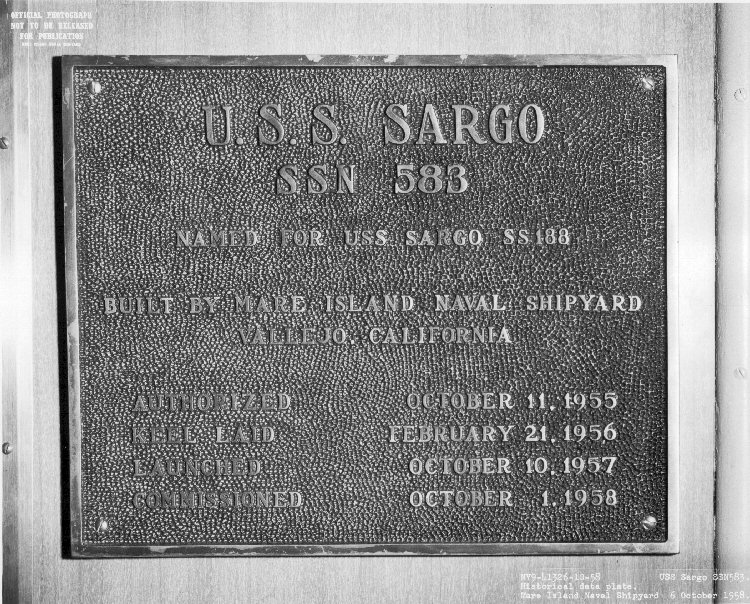 Courtesy Tom Hansen
Courtesy Tom Hansen
|
| The Commissioning Plaque. Photo taken in October 1958. |

| Follow this link to the Commissioning Crew |
| The following photos of shipmates from the commissioning crew were provided by Ellie Goode: |

|
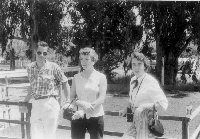
|
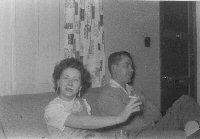
|
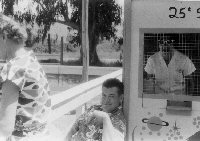
|
| Earl L. Gayle MMC(SS) | Floyd L. Laughrun CS1(SS) | ENS Herbert E. Menzel, Jr. | LeRoy Ingles TMC(SS) - COB |
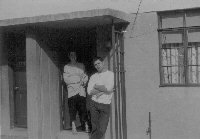
|

|
||
| Phillip S. Thompson EN1(SS) | William J. Andrew EN2(SS) |


|
|
CDR Daniel P. Brooks LCDR Roth S. Leddick LCDR John H. Schulte LT Stanley J. Anderson LT Edward O. Dietrick LT Robert M. Douglass LT Paul D. Tomb LT Francis L. Wadsworth LT Whitney Hansen ENS Herbert E. Menzel, Jr. |

|
|
|
|
